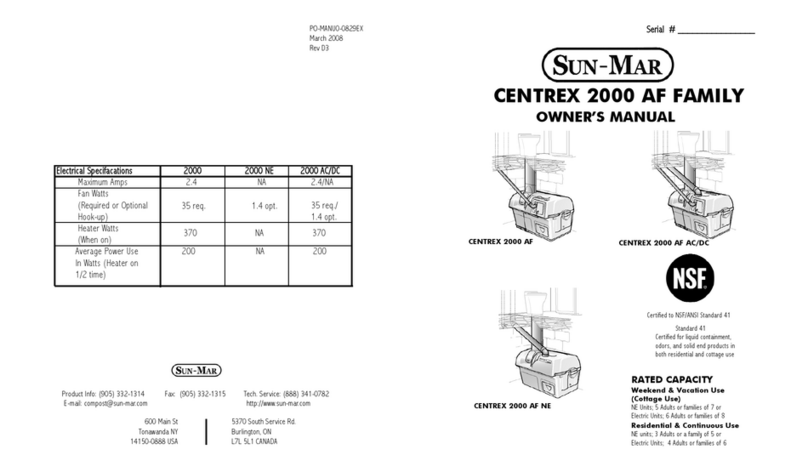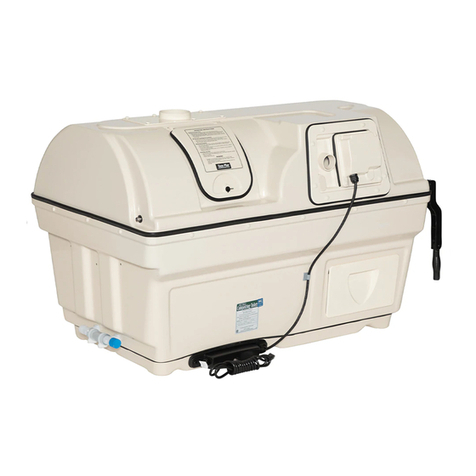- 6 -
Symptom Cause Remedial Action Prevention
Urine Odour
in
Washroom
Occasional
Urine Odor
Outside
Strong
Sewage
Odor
Fan Noisy
Horizontal runs or
downward slopes on
vent pipe
Fan has failed
Downdraft
Competing appliances
1. Vent stack not
installed above
peak of roof.
2. If vent stack is
installed above
roof line,natural
obstructions,such
as tall trees,being
located in a valley
or close to a hill
may be causing
downdraft.
Compost is anaerobic
Fan damaged in ship-
ping or bearings are
beginning to wear.
Re-install the vent so there are no horizontal or low
points where condensation can collect.
Have your serial number ready and call SUN-MAR for
a replacement. Instructions are included with the
replacement fan.
If you believe that there may be a downdraft outside
of the building,it may be a good idea to remove your
fan assembly prior to installation and set the fan gate
to ‘0’ to prevent urine odor in the bathroom. (electric)
Install a 12 volt fan in vent pipe. (NE)
Wood stoves or furnaces installed in a tightly sealed
room with the composting toilet may draw air in caus-
ing a vacuum in the room. This will draw air down the
vent pipe.
1. Check that the vent is installed above the peak
of the roof.If not, extend the vent. Guide wires
may be necessary.
2. Add lime to the evaporation chamber - as much
as you think necessary. You will have to rake
more often if you do this.
3. SUN-MAR has a filter box available which will filter
the ammonia out of the vented air in a downdraft
situation. Call SUN-MAR for details.
Begin following: “Compost Troubleshooting” sugges-
tions.
1. If it is rattling,it may need to be cleaned or the
bearings are worn and the fan needs to be
replaced.
2. A hum is the normal sound the fan will make.. If
you are in a very quiet setting it will be more
noticeable.If this is the case,consider purchasing
a fan speed control so that the fan may be turned
down.
Install wall brackets on vent pipe to pre-
vent settling.DO NOT install horizontal
runs as liquid will collect and block ven-
tilation, causing odour.
The fan is a constantly moving part and
has a finite service life.
Install an air intake to the competing
appliance from the outside.
Downdraft is dependent on wind direc-
tion as well as natural obstructions etc.
Initially, install the vent above the peak
of the roof.If symptoms occur,add lime
or a filter box.
Follow “Ongoing Maintenance” and use
proper bulking material.
Clean the fan with a small brush and/or
compressed air nozzle once a year. To
do this, remove the fan assembly by tak-
ing offthe snap cap covers and
unscrewing the screws which hold it in.
The entire assembly will then simply
slide out. This will prevent wear and
lengthen the life of your fan.
- 15 -
1) Compost will be removed from the finishing drawer.Ensure that there is at least 17” in front of
the CENTREX 2000 so that the drawer may be removed from the unit.
2) Install the unit in a location where the safety drain can be connected. This drain exits from the
left side of the unit and must slope downward at all points.
3) Install in a location where the vent pipe can be attached as per the instructions listed below.
4) Install in a location that is not air tight.
5) Ensure that the CENTREX 2000 is accessible for ongoing maintenance.
6) Ensure that the installation area is a minimum height of 28”.
WE DO NOT RECOMMEND
DIGGING BELOW GROUND TO FACILITATE THE INSTALLATION OF THE CENTREX 2000.
7) Ensure the CENTREX 2000 is protected from precipitation.
1) If running a vent through a wall, it should be done at a 45° angle to prevent condensation from
accumulating in the vent pipe,causing a constriction.
THERE SHOULD BE NO HORIZONTAL
SECTIONS OF VENT.
Venting should be installed vertically.
2) All vent pipe that is exposed to the outside or in a non-heated space should be insulated if
using the unit during cold weather.
3)
INSTALL VENT SO THAT IT TERMINATES 24” - 30” ABOVE HIGHEST PEAK OF THE ROOF.
4) If you will be installing venting on a steeply pitched roof where snow shear may occur;Install a
heavier pipe through the roof and feed the enclosed vent through the heavier pipe.Seal
between the pipes with expandable foam or other such water-tight substance. The heavier pipe
should be able to withstand the weight of sliding snow.
5) If there is more than 36” of vent needed above the roof line to reach 24-30” above the highest
peak of the roof (diffusor included in measurement), use guy wires to secure the vent above
the roof.
6) Limit bends in the vent stack to no more than 4 that have a combined total of 180 °.
7) The vent must be installed separately from ALL other household vents. Venting cannot be
merged with other venting.Doing so will prevent the unit from operating odorlessly.
8) All connectors in the vent pipe should be sealed.
Use silicone caulking to seal the connection
between the vent and the fan.
PVC cement may be used all other vent connections.
9) The diffusor should be glued vertically on to the top of the vent pipe. This assembly helps draw
air up the vent pipe.
Possible venting configurations for
the 2” electric vent pipe.
A ground fault interrupter (GFI) circuit is recommended for any unit installed in an environment where
it will be exposed to moisture. This may be installed directly on the wall socket or at the circuit
breaker.If you are in an area where you experience power fluctuations, you may wish to install a surge
protector.
Some 230V models may have an over current fuse protection on the heating element circuit which is
located on the electric box.
Space
Required and
other
Installation
Considerations
Vent Pipe
Location
Electrical
Considerations
MECHANICAL TROUBLE SHOOTING
CENTREX 2000 Electric Installation





























